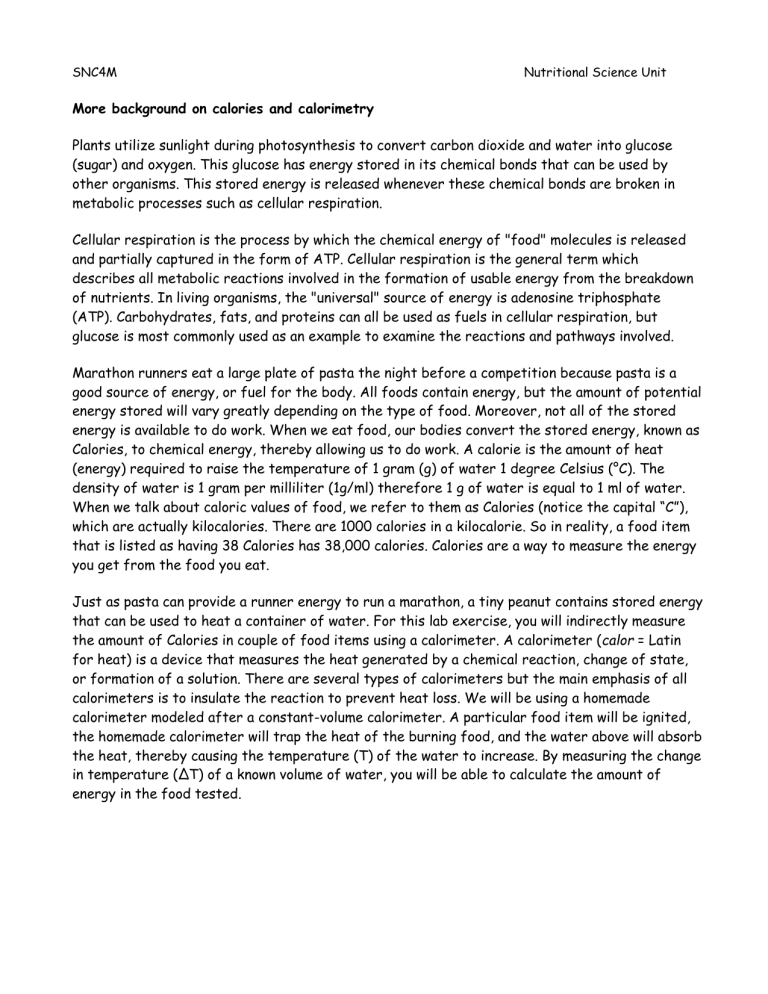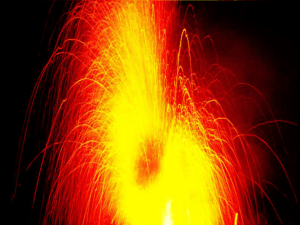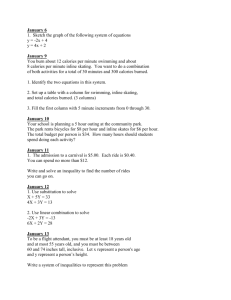Calorimetry lab background

SNC4M
More background on calories and calorimetry
Nutritional Science Unit
Plants utilize sunlight during photosynthesis to convert carbon dioxide and water into glucose
(sugar) and oxygen. This glucose has energy stored in its chemical bonds that can be used by other organisms. This stored energy is released whenever these chemical bonds are broken in metabolic processes such as cellular respiration.
Cellular respiration is the process by which the chemical energy of "food" molecules is released and partially captured in the form of ATP. Cellular respiration is the general term which describes all metabolic reactions involved in the formation of usable energy from the breakdown of nutrients. In living organisms, the "universal" source of energy is adenosine triphosphate
(ATP). Carbohydrates, fats, and proteins can all be used as fuels in cellular respiration, but glucose is most commonly used as an example to examine the reactions and pathways involved.
Marathon runners eat a large plate of pasta the night before a competition because pasta is a good source of energy, or fuel for the body. All foods contain energy, but the amount of potential energy stored will vary greatly depending on the type of food. Moreover, not all of the stored energy is available to do work. When we eat food, our bodies convert the stored energy, known as
Calories, to chemical energy, thereby allowing us to do work. A calorie is the amount of heat
(energy) required to raise the temperature of 1 gram (g) of water 1 degree Celsius (°C). The density of water is 1 gram per milliliter (1g/ml) therefore 1 g of water is equal to 1 ml of water.
When we talk about caloric values of food, we refer to them as Calories (notice the capital “C”), which are actually kilocalories. There are 1000 calories in a kilocalorie. So in reality, a food item that is listed as having 38 Calories has 38,000 calories. Calories are a way to measure the energy you get from the food you eat.
Just as pasta can provide a runner energy to run a marathon, a tiny peanut contains stored energy that can be used to heat a container of water. For this lab exercise, you will indirectly measure the amount of Calories in couple of food items using a calorimeter. A calorimeter (calor = Latin for heat) is a device that measures the heat generated by a chemical reaction, change of state, or formation of a solution. There are several types of calorimeters but the main emphasis of all calorimeters is to insulate the reaction to prevent heat loss. We will be using a homemade calorimeter modeled after a constant-volume calorimeter. A particular food item will be ignited, the homemade calorimeter will trap the heat of the burning food, and the water above will absorb the heat, thereby causing the temperature (T) of the water to increase. By measuring the change in temperature (∆T) of a known volume of water, you will be able to calculate the amount of energy in the food tested.
Notes about procedure:
1.
You will need to use between 100-300 ml of water and the amount should be measured in a graduated cylinder.
2.
Use plastic weigh boats to weigh your food items before and after burning. Wait until your food item has cooled before putting it into the weigh boat. Do not forget to tare the weigh boat.
3.
Keep the food label because you will need the serving size and the calories per serving.
4.
Measure the mass of the food prior to burning
Precautions:
You are working with an open flame so hair needs to be tied back and caution taken not to burn your clothing. Do not touch the metal can with your hands – use beaker or crucible tongs to avoid burning yourself.
Data collection:
The table below is just a suggestion but you should collect and present the information below in some way.
Table 1 - Data Analysis from Nut Calorimetry
Temperature before
Food item#1 Food item#2 burning food item (
o
C)
Temperature after burning food item (
o C)
Temperature change
(
o
C)
Mass of water (g)
Mass of food item before burning (g)
Mass of food item after burning(g)
Mass of food burned
(g)
Serving size (from label)
Calories per serving
(cal/g)
* note that calories are food calories which are 1000 calories or 1 kcal
Food item#3
Calculations:
Q lost by food
= Q gained by water
The energy gained by the water (and lost by the food) can be calculated as follows:
Q water
= (m)(c)(ΔT)
Q is the heat gained in calories (cal)
m is the mass of water in grams (g)
c is the specific heat capacity of water (1 calorie/g °C)
ΔT is the change in temperature in degrees Celsius (°C)
*Remember that the density of water is 1g/ml therefore 1 g of water = 1 ml of water.
Let's work through an example to make sure that the equation is clear. (We'll use made-up numbers for the example. You'll have to try the experiment for yourself to get actual measurements.) So let's say that we start out with 100 g of water in the calorimeter (m = 100 g).
The initial temperature of the water is 20°C. After burning up some small piece of food, we measure the water temperature again, and find that the final temperature is 24°C. Now we have all of the information we need to calculate the amount of heat captured by the calorimeter:
Now you can see why the specific heat capacity of water has such strange units (cal/g°C). Notice that the grams (g) from the mass of the water and the degrees Celsius (°C) from the change in temperature cancel out with the grams (g) and degrees Celsius (°C) in the denominator of the units for specific heat. That way you are left with units of calories (cal), which is what you want.
A Note on Units
A calorie (lowercase "c") is actually defined by the heat capacity of water. One calorie is the amount of energy that will raise the temperature of a gram of water by 1°C. When we talk about food energy, we also use the word "Calorie," (note uppercase "C") but it is a different unit. It is the amount of energy needed to raise the temperature of a kilogram (= 1000 grams) of water by
1°C. So a Calorie is the same as 1000 calories. Or, to put it another way, 1 Calorie = 1 kcal. So in this project, for food Calories we will be careful always to use an uppercase "C".
For your lab report, you need to have a discussion or analysis section in which you answer the questions below, and a conclusion:
Questions & Conclusion:
1. How many Calories are in each whole food item you tested?
2. Were you able to determine the entire Calorie content of the food item? Why?
3. Do you think the number of Calories you calculated is likely to be lower or higher than it really is? Explain why.
4. What is the original source of energy in all of the foods tested?
5. Which group of macromolecules would your food items contain --- carbohydrates, lipids, or protein, or a number of these?
6. Describe specific ways you could make a more efficient calorimeter than the one we used in this lab.
7. Compare the energy yield for the different foods you burned. Why is the energy yield different between your different food items?
8. If a person is trying to lose weight, which foods (protein, fats, carbohydrates) should they decrease in their diet? Explain why.
9. In this lab we used a calorimeter to burn (oxidize) the food, but living things don’t use fire to oxidize food. What process do living things use to get the energy out of food? Where does this process occur?
10. What are three potential sources of error?







